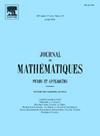Harmonic analysis in Dunkl settings
IF 2.3
1区 数学
Q1 MATHEMATICS
引用次数: 0
Abstract
Let L be the Dunkl Laplacian on the Euclidean space associated with a normalized root R and a multiplicity function . In this paper, we first prove that the Besov and Triebel-Lizorkin spaces associated with the Dunkl Laplacian L are identical to the Besov and Triebel-Lizorkin spaces defined in the space of homogeneous type , where . Next, consider the Dunkl transform denoted by . We introduce the multiplier operator , defined as , where m is a bounded function defined on . Our second aim is to prove multiplier theorems, including the Hörmander multiplier theorem, for on the Besov and Tribel-Lizorkin spaces in the space of homogeneous type . Importantly, our findings present novel results, even in the specific case of the Hardy spaces.
Dunkl设置中的谐波分析
设L为欧几里德空间RN上的Dunkl拉普拉斯算子,该算子具有归一化根R,且多重函数k(ν)≥0,ν∈R。在本文中,我们首先证明了与Dunkl拉普拉斯算子L相关的Besov和triiebel - lizorkin空间与定义在齐次型空间(RN,‖⋅‖,dw)中的Besov和triiebel - lizorkin空间是相同的,其中dw(x)=∏ν∈R < ν,x > k(ν)dx。接下来,考虑用F表示的Dunkl变换。我们引入乘数算子Tm,定义为Tmf=F−1(mFf),其中m是定义在RN上的有界函数。我们的第二个目标是在齐次型空间(RN,‖⋅‖,dw)的Besov和Tribel-Lizorkin空间上证明Tm的乘数定理,包括Hörmander乘数定理。重要的是,我们的发现提出了新颖的结果,即使在哈代空间的具体情况下。
本文章由计算机程序翻译,如有差异,请以英文原文为准。
求助全文
约1分钟内获得全文
求助全文
来源期刊
CiteScore
4.30
自引率
0.00%
发文量
84
审稿时长
6 months
期刊介绍:
Published from 1836 by the leading French mathematicians, the Journal des Mathématiques Pures et Appliquées is the second oldest international mathematical journal in the world. It was founded by Joseph Liouville and published continuously by leading French Mathematicians - among the latest: Jean Leray, Jacques-Louis Lions, Paul Malliavin and presently Pierre-Louis Lions.

 求助内容:
求助内容: 应助结果提醒方式:
应助结果提醒方式:


